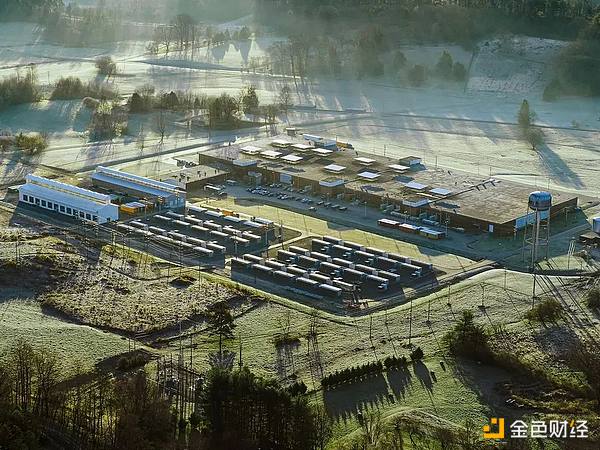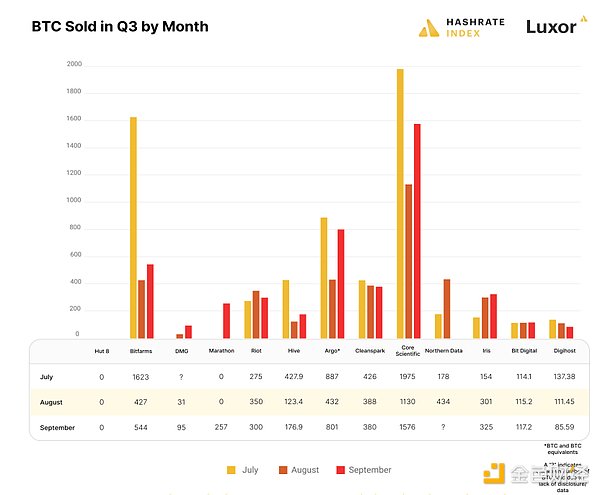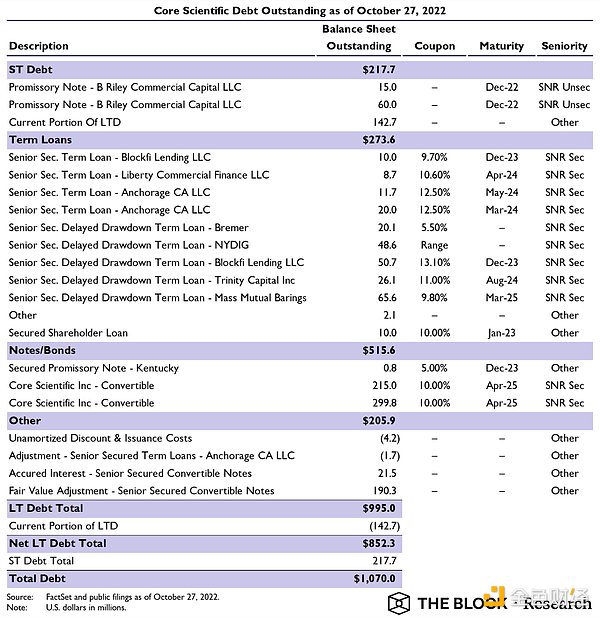Core Scientific, one of the largest publicly traded crypto mining companies in the U.S. with a purported 457 MW of operations, filed a statement with the U.S. Securities and Exchange Commission last week citing the possibility of bankruptcy in the future, the company also revealed , it won’t pay its debt due in late October and early November, and its stock price plummeted 77%, further widening the endgame for Core.
Why is North America’s largest miner Core Scientific (hereinafter referred to as “Core”) now on the brink of bankruptcy? Let’s start with history and find out why.

News Source: Shares of CoinDesk Troubled Bitcoin Miner Core Scientific Continue to Plunge on Bankruptcy Risks
History introduction
Core has been operating mining farms in North America since 2017, both self-mining and hosting services. Core has mines in Georgia, Kentucky, North Carolina, North Dakota and Texas, and expects to begin operations in Oklahoma in the coming quarters.
- How Does Musk’s acquisition of Twitter affect Dogecoin?
- Hong Kong Issues Policy Declaration on virtual asset development
- Dubai, the Web 3 capital of the desert
Core is very secretive and rarely discloses trading details to the market. Early in 2018, a filing revealed the startup was raising a $40 million investment round, and three months later it was revealed that founder Aber Whitcomb was raising a massive $100 million investment that could grow to $2.5 million. billion, but he declined to provide details on how the investment would be used.
In July 2021, Core announced a merger with Power & Digital Infrastructure Acquisition Corporation (XPDI) to list on the Nasdaq at an enterprise valuation of approximately $4.3 billion. Previously, Core purchased 76,595 and 112,800 Bitmain mining machines in 2020 and 2021 respectively, all of which are new-generation mining machines such as S19, S19 Pro, S19J and S19J Pro. Supported by the bull market, holding these mining machine assets continues to push up Core’s market valuation.

Source: Core Scientific, Marble facility in North Carolina
After that, Core and an affiliate of private independent energy company Tenaska Energy, Inc. reached an agreement to build a 300 MW data center in Denton, Texas, for which Core committed to invest $200 million, expected by the end of 2022 Facility construction will be completed.
In addition to this, Blockcap, founded in 2020 by former Core executives, has so far purchased 42,000 mining machines from Bitmain and Canaan, 12,000 of which are already operational. The company plans to have an additional 18,000 miners on the shelf by the fourth quarter of 2022, and then 12,000 more by 2022, all hosted on Core’s own mining farms.
According to a press statement on Core’s official website, the company expects to run about 325,000 mining machines (combined with self-mining and hosting) in its data center by the end of the year, and has a purchase plan for about 90,000 mining machines. The pressure to pay principal and interest is increasing, and there is still a question mark as to whether more than 320,000 mining machines can be deployed as scheduled.
Before June 2022, Core implemented a HODL strategy (holding Bitcoin for a long time). After June, mining machine orders, mining farm capital expenditures and debts were like three mountains, forcing Core to start a large number of Sell bitcoins.
As a result, it sold 7,202 bitcoins in June, raising about $167 million; in August, it sold 1,125 bitcoins, raising about $25.9 million; in September, it sold 1,576 bitcoins, raising about $32.2 million in total Dollar. As of Oct. 26, the company held just 24 bitcoins and about $26.6 million in cash.

Source: Hashrate Index
As can be seen intuitively from the graph, Core sold more Bitcoin than all other listed miners. What the hell happened this year to make Core start selling bitcoin so much that it might even go bankrupt due to cash flow issues?
Situation Analysis
Private and publicly listed crypto miners owe as much as $4 billion as of July 2022 to fund the construction of sprawling facilities across North America, according to data compiled by industry players and CoinDesk.
Core is also part of a wild expansion. As mentioned earlier, it expects to deploy over 320,000 mining machines by the end of 2022. what is this concept? Excluding the hosting machines, the total value is roughly estimated to be nearly $1 billion (according to the spot market price, if the purchase time node is earlier, the purchase cost of the mining machine may be higher). This is only the amount of mining machines, and it does not take into account mining farm construction expenses, electricity costs for large-scale deployment of mining machines, and loan interest.
If the price of the currency remains high and the miners can pay the electricity bill, then the Core can maintain the cash flow and realize its great cause step by step.
However, an Oct. 19 court filing revealed that Celsius in the crypto lending space had unpaid electricity bills totaling about $2.1 million to Core in August and September of this year, and Core was still losing about $53,000 a day in electricity bills , a month is 1.59 million US dollars.

News: Celsius Network fails to pay Core Scientific, leading to financial turmoil
Celsius was once one of the largest companies in the crypto lending space, offering annual returns of nearly 19%, but it filed for bankruptcy this spring.
Core had an agreement with it to provide its infrastructure. According to the agreement, mining machines and mining revenue belong to Celsius, while Core only charges electricity and hosting fees.
In the filing, Core asked the court to compel Celsius to pay overdue bills or allow it to perform contracts. “Celsius either needs to comply with the contract, or Core and Celsius must terminate their relationship before Celsius causes another business partner (Core) to enter bankruptcy proceedings.”
The game has yet to settle down. U.S. Judge Martin Glenn will preside over their hearing next month, and the outcome remains to be seen.
Caused by a series of factors, such as the debt owed by Celsius, is the high debt that is difficult to repay. According to statistics, Core’s total debt principal is about $1 billion, including investment bank B. Riley, MassMutual Barings and crypto lender BlockFi, as of October 27, Core owed them $75 million, $65.6 million, and $60.7 million, respectively .
In addition to this, a total of $48.6 million in deferred senior secured instalments owed to crypto financial services firm NYDIG and $31.7 million in senior secured instalments from Anchor Labs, the parent company of digital asset bank Anchorage Digital., and most debt will expire in three years.

Source: THE BLOCK Research
Reason interpretation
Bitcoin’s price has fallen from an all-time high of over $69,000 in November 2021 to around $20,500, a loss of nearly 70% in value, which, combined with intense competition among miners and rising energy prices, has compressed mining profit margins.
The bulk of Core’s loans were used to buy mining machines and build mining farms, and most of them began in the second half of 2021, when Bitcoin prices were rising (peaking at nearly $70,000 in November) and miners were racing to grow their business.
Bull markets always amplify desire and reduce risk control. It has to be said that under the big market in 2021, many people have a floating mentality, crazy expansion, and crazy leverage: the overall investment cost of mine construction last year was high, and the average market price may be 250-500,000 US dollars / MW, mergers and acquisitions At the time of mining, the valuation can even reach 1 million US dollars/MW; the unit price of buying mining machines is between 55 – 105 USD/T (the price of S19J Pro falls to less than 20 U/T). Under the double attack, the huge investment in assets in the early stage and the sharp drop in income have made it difficult for many mining companies to continue.
The specific purchase price of Core has not been disclosed, but we can know that it still needs to pay Bitmain cash on a monthly basis. When the cash flow can’t keep up, then its default on Bitmain is real. Coupled with the increase in energy and electricity prices in the United States, and the increase in operating costs, even if the original bitcoin is continuously sold to replenish cash, the stock will eventually be exhausted. cash out.
Under multiple pressures, the Celsius incident was like the first domino that fell, triggering this series of crises.
Will Core really go bankrupt? We have no way of knowing, but here is a passage from Compass Point for your interpretation:
“With the price of mining rigs falling significantly in 2022, we think there is a good chance that the creditors holding this debt will decide to restructure rather than take the collateral. Nonetheless, without knowing the discussions with Core creditors, we believe it must be taken seriously Treat Core’s application for Chapter 11 protection, especially if Bitcoin prices fall further from current levels.”
Like what you're reading? Subscribe to our top stories.
We will continue to update Gambling Chain; if you have any questions or suggestions, please contact us!